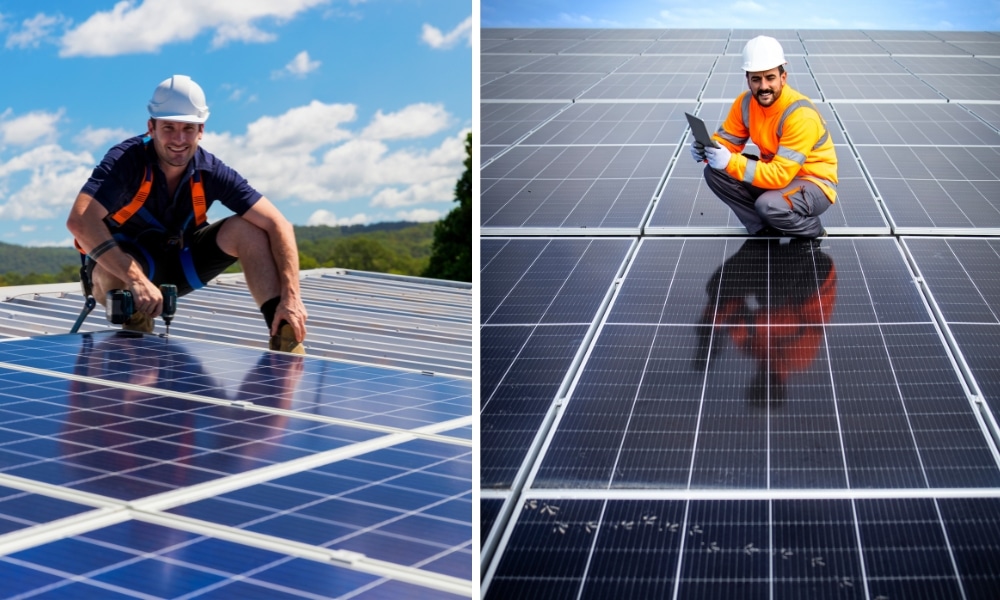With its abundant sunshine hours, Australia is a prime location for harnessing solar power. However, various factors exist when choosing panels, including solar panel types. Two dominant players in the market are monocrystalline and polycrystalline solar panels. Both offer efficient ways to convert sunlight into electricity, but their distinct characteristics can impact your solar journey. This article delves into the benefits of each type to help you make an informed decision for your Australian home and business.
Ready to upgrade your solar systems and take your energy savings to the next level? Embrace the energy efficiency revolution by upgrading your solar systems and adding a battery or solar inverters with Energy Matters.
With our 3 free solar quotes, you can compare plans from pre-qualified and vetted installers in your area and find the perfect solution for your home and business. Harness the sun’s power and save money on electricity bills while reducing environmental impact. Let Energy Matters guide you towards a brighter, more sustainable future.
Understanding solar panel types: Monocrystalline vs. polycrystalline
Both monocrystalline and polycrystalline solar panels convert sunlight into electricity using the photovoltaic effect. However, key differences lie in their manufacturing process and cell structure, impacting their performance and aesthetics.
- Monocrystalline solar panels: Crafted from a single, pure silicon crystal, these panels boast a uniform, black appearance. The silicon undergoes a meticulous growth process, resulting in a highly organised atomic structure. This translates to superior efficiency, meaning they convert more sunlight into electricity than their polycrystalline counterparts. Read more about Monocrystalline Solar Panels.
- Polycrystalline solar panels: These panels are formed by melting and solidifying multiple silicon crystals. This process creates a grainy, blue-tinged appearance with a less uniform structure. While less efficient than monocrystalline panels, polycrystalline panels are generally more affordable. Read more about Polycrystalline Solar Panels.
Monocrystalline vs. polycrystalline solar panels: A comparison
Monocrystalline solar panels | Polycrystalline solar panels | |
1.Efficiency | These panels are made from a single silicon crystal, resulting in higher efficiency. They can convert sunlight into electricity more effectively, making them ideal for residential use. | These panels consist of multiple silicon crystals. While they are less efficient than monocrystalline panels, they offer a cost-effective alternative. |
2.Durability | Known for their durability, monocrystalline panels have a longer lifespan (up to 25 years). Their sleek design and single-crystal structure contribute to their robustness. | Although slightly less durable, polycrystalline panels are still reliable. They combine silicon fragments and melt them together, providing a budget-friendly option. |
3.Cost | These premium panels come at a higher price point due to their superior efficiency and manufacturing process. | If you’re looking for a more affordable option, polycrystalline panels are the way to go. They offer decent performance without breaking the bank. |
4.Appearance | Sleek and black, monocrystalline panels blend seamlessly into rooftops. | These panels have a blue-speckled appearance, which may be less aesthetically pleasing but doesn’t impact their functionality. |
Benefits of monocrystalline solar panels for Australian homes
Monocrystalline solar panels offer several advantages for Australian homes, particularly those with limited roof space or seeking to maximise energy output:

- Higher efficiency: Monocrystalline panels are the efficiency champions, typically converting 18-22% of sunlight into electricity. This translates to generating more power with fewer panels, a crucial factor for smaller roofs. In Australia’s sunshine-rich environment, every watt counts!
- Space optimisation: Due to their higher efficiency, monocrystalline panels require less space to achieve the desired energy output. This is ideal for homes with limited roof real estate or specific shading patterns.
- Performance in weaker sunlight: While Australia receives excellent sunlight, there can be occasional cloudy days. Monocrystalline panels perform slightly better in low-light conditions than polycrystalline panels, ensuring consistent energy production even during less sunny periods.
- Durability and longevity: Monocrystalline panels are known for their superior durability and can withstand harsh Australian weather conditions. With a lifespan exceeding 25 years, they offer a long-term return on investment.
- Aesthetics: For some homeowners, aesthetics are important. Monocrystalline panels have a sleek, black appearance that some find more visually appealing on their roofs.
Considering the cost factor: Monocrystalline panels are more expensive than polycrystalline options. However, their higher efficiency can lead to long-term cost savings through increased energy production.
Benefits of polycrystalline solar panels
Despite lower efficiency, polycrystalline solar panels hold their own set of advantages:
- Cost-effectiveness: Polycrystalline panels are generally the more affordable option. This can be a significant factor for budget-conscious homeowners looking for an initial cost advantage.
- Suitable for larger roofs: If you have ample roof space, the lower efficiency of polycrystalline panels might be a minor concern. You can simply install more panels to achieve your desired energy output.
- Technological advancements: The efficiency gap between mono and polycrystalline panels is narrowing. Manufacturers constantly improve polycrystalline technology, making them a more attractive option in specific scenarios.

Making the choice: Monocrystalline vs. polycrystalline for your Australian home and business
Ultimately, your best choice depends on your specific needs and priorities. Consider these factors:
- Roof size and shading: Monocrystalline panels solve limited roof space or shading concerns.
- Budget: If upfront cost is a major consideration, polycrystalline panels might be better.
- Energy needs and long-term savings: Evaluate your current and future energy needs. Monocrystalline panels might pay off in the long run due to their higher efficiency and potential system size reduction.
- Aesthetics: Do you prefer the sleek black look of monocrystalline panels, or are you comfortable with the blue hue of polycrystalline varieties?
Consulting a solar installer: A reputable solar installer can assess your situation and recommend the most suitable solar panel type for your Australian home. They can provide detailed quotes comparing monocrystalline and polycrystalline options, considering your roof space, energy needs, and budget.

Ready to take control of your energy bills and switch to solar? Contact Energy Matters today, and we’ll connect you with up to 3 FREE solar quotes from trusted local solar installers!
Beyond solar panel types: Additional considerations
Remember, solar panel types are just one aspect of your solar power journey. You must consider factors like energy consumption, roof size and orientation, and government incentives available in your region. Consulting with a reputable solar installer can help you assess your needs and recommend the most suitable solar panel system for your Australian home and business.
By understanding the benefits of monocrystalline and polycrystalline solar panels, you’ll be well on your way to making an informed decision and harnessing the sun’s power to light up your Australian home.
Ready to go solar? Get an instant assessment
To find out how much a solar system with storage or even an EV charger will cost, try our easy-to-use solar power and battery storage calculator! It will generate performance data and possible cost savings.
We can forward your information to 3 trusted local installers in your area to obtain free, no-obligation solar quotes.
Find out how much you can expect to pay for solar
Ready to find out more? Get FREE quotes for solar, batteries + more
*Prices quoted are to be used as a guide only and do not factor in state and other rebates and incentives. Includes STC discount.
Our Energy Matters CEO, Roshan Ramnarain, will feature stunning homes installed with the latest solar technology every Saturday at 5:00 p.m. on Open Homes Australia on the 9Life channel. Be sure to watch this show; you won’t want to miss it!















































